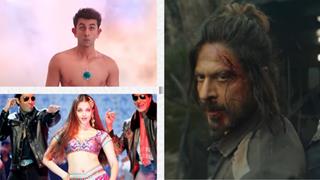Bollywood's latest venture "Kaal" has ruffled the features of animal activists and the apex court for alleged violation of animal rights.
The Supreme Court's notice to super star Shah Rukh Khan and filmmaker Karan Johar on a petition alleging that their co-produced film "Kaal" violates the Wildlife Protection
Act among others is not the first time the Hindi-film industry has been accused of breaching animal rights.
Former central minister and environment activist Maneka Gandhi informed the court that the film was shot in the Corbett National Park in Uttaranchal without proper
permission from the Chief Wildlife Warden as required under the Wildlife Act. Besides, wild animals were used in the film.
The allegation is that the film was shot in the national park in violation of the court's earlier orders not to use wild animals for commercial purposes.
Big-budget "Kaal" (or Doomsday) was publicized by debutant director Soham Shah as a pro-conservation film.
At the movie's premier Soham said: "Wildlife has always been neglected by Indian filmmakers, so I thought why not make a film on it. There are hardly any tigers left in India
despite the fact that the tiger is our national animal."
The film, however, breaks all rules. The opening shot features actor John Abraham with a python, a clear violation. The film goes on to portray game hunting as common and
rampant. The film also to an extent allegedly reinforces the myth that tigers hunt humans.
Activists say cruelty to animals in movies is rampant and unchecked. Led by Maneka Gandhi, these activists are fighting a system, which they say, is turning a blind eye to
the issue that can spillover and increase violence on these voiceless beings in real life as well.
Gandhi has been vociferous in her tirade against the Central Board of Film Certification (CBFC) on this issue. She has been advocating that animal rights activists should be
part of the Censor Board as was the case in 1998.
According to the Prevention of Cruelty to Animals Act and Performing Animals Rules it is mandatory for anyone using an animal for the purpose of entertainment - to which
admission is charged - to apply to the government for permission, stating exactly what the animal will be required to do.
A copy of the permission certificate has to be submitted to the Animal Welfare Board of India (AWBI). Even if permission to use animals in films is granted, it is still
punishable to inflict any manner of pain or suffering on them. One also has to pay for an inspector to be present whenever an animal is used to ensure no cruelty is done.
"None of Bollywood's 14 listed animal suppliers have registered themselves with the AWBI. This registration is compulsory under the Performing Animals Act. We have
written to all of them that they are on the wrong end of the law," says activist Anuradha Sawhney.
"If you make a movie telling that it is cool to hate and kill lizards, then you are actually influencing a whole generation to do the same," she says.
A horse was seriously injured during the shooting of "Bhola Bhala" after being deliberately tripped. The dog Jaani of "Parivaar" was killed after a glass-breaking stunt in a
movie, says Sawhney.
She added that several TV advertisements, including the BPL ad with elephants and the Pepsi ad featuring Preity Zinta and a monkey have been withdrawn. In 1994, an
NGO convinced the CBFC to censor certain parts of the film "Betaaj Badshah" in which the mouth of a leopard had been sewn up.
She said the rules do not in any way come in the way of artistic licence. "Would you murder or rape people to depict life in films? So why do you have to be cruel and
insensitive to animals in the name of artistic licence?" she asked.
Bollywood however, does not seem to be listening.
Salman Khan is fighting a court case for allegedly hunting endangered black bucks. Aamir Khan also faced flak for violating animal rights for his first production "Lagaan".
Interestingly, Shah Rukh is the last of Bollywood's three Khans to face allegations of animal rights violation.
SC notice to Johar's Kaal
Tuesday, May 03, 2005 18:18 IST
















